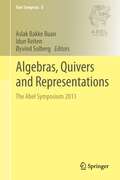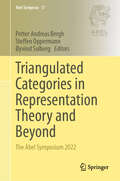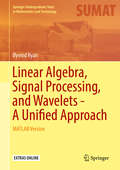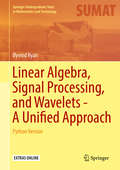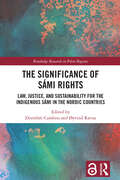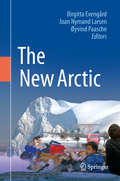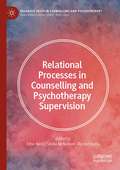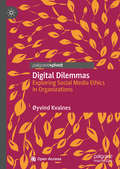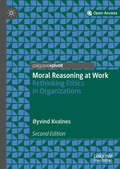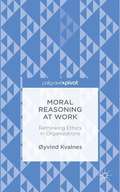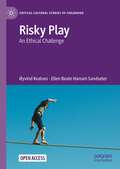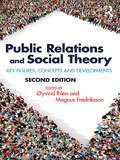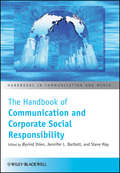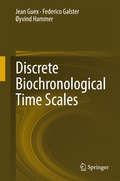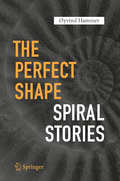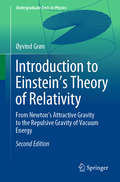- Table View
- List View
Making CO2 a Resource: The Interplay Between Research, Innovation and Industry (Routledge Explorations in Environmental Studies)
by Elin M. Oftedal Øyvind StokkeThis interdisciplinary book explores how CO2 can become a resource instead of a waste and, as such, be a tool to meet one of the grandest challenges humanity is facing: climate change.Drawing on a Norwegian narrative that has significance for a global audience, Øyvind Stokke and Elin Oftedal introduce in-depth, multi-perspective analyses of a sustainable innovation research experiment in industrial carbon capture and utilisation technologies. Building on extensive literature within marine sciences, sustainability research, and environmental philosophy and ethics, this book documents how a misplaced resource like CO2 can become valuable within a circular economy in its own right, while at the same time meeting the challenge of food security in a world where food production is increasingly under pressure. The book is diverse in scope and includes chapters on how to reduce the environmental footprint of aquaculture by replacing wild fish and soy from the Amazon, how to optimise the monitoring of aquatic environments via smart technologies, and how to replace materials otherwise sourced from natural environments. The authors also analyse the pivotal role of the university in driving innovation and entrepreneurship, the pitfalls of different carbon technologies, and explore how the link between petroleum dependence and CO2 emissions has been addressed in Norway specifically.Making CO2 a Resource will be of great interest to students and scholars of climate change, environmental ethics, environmental philosophy, sustainable business and innovation, and sustainable development more broadly.
Power-Sharing in Conflict-Ridden Societies: Challenges for Building Peace and Democratic Stability
by Nils A. Butenschøn Øyvind Stiansen Kåre VollanBased on a unique comparative study of Burundi, Rwanda, Ethiopia, Lebanon, Bosnia-Herzegovina, Nepal, Myanmar, the Philippines, and Fiji this book analyses the formal and informal arrangements defining the post-conflict political order in these countries and evaluates whether these systems strengthened or weakened the chances of establishing sustainable peace and lasting democracy. What can be learned from these cases? Each country has it unique history but they are faced with comparable challenges and dilemmas in building a democratic future. Which solutions seem to contribute to democratic stability and which do not? These questions are discussed in light of theoretical literature, case studies, and field interviews with the authors concluding that systems based on proportional representation offered the best prospects for including diverse and conflicting identities and building unified political systems. The book is of particular interest to students of democracy and peace-building; academics as well as decision-makers and practitioners in the field.
Snake Robots
by Kristin Y. Pettersen Øyvind Stavdahl Jan Tommy Gravdahl Pål LiljebäckSnake Robots is a novel treatment of theoretical and practical topics related to snake robots: robotic mechanisms designed to move like biological snakes and able to operate in challenging environments in which human presence is either undesirable or impossible. Future applications of such robots include search and rescue, inspection and maintenance, and subsea operations. Locomotion in unstructured environments is a focus for this book. The text targets the disparate muddle of approaches to modelling, development and control of snake robots in current literature, giving a unified presentation of recent research results on snake robot locomotion to increase the reader's basic understanding of these mechanisms and their motion dynamics and clarify the state of the art in the field. The book is a complete treatment of snake robotics, with topics ranging from mathematical modelling techniques, through mechatronic design and implementation, to control design strategies. The development of two snake robots is described and both are used to provide experimental validation of many of the theoretical results. Snake Robots is written in a clear and easily understandable manner which makes the material accessible by specialists in the field and non-experts alike. Numerous illustrative figures and images help readers to visualize the material. The book is particularly useful to new researchers taking on a topic related to snake robots because it provides an extensive overview of the snake robot literature and also represents a suitable starting point for research in this area.
Algebras, Quivers and Representations: The Abel Symposium 2011 (Abel Symposia #8)
by Idun Reiten Øyvind Solberg Aslak Bakke BuanThis book features survey and research papers from The Abel Symposium 2011: Algebras, quivers and representations, held in Balestrand, Norway 2011. It examines a very active research area that has had a growing influence and profound impact in many other areas of mathematics like, commutative algebra, algebraic geometry, algebraic groups and combinatorics. This volume illustrates and extends such connections with algebraic geometry, cluster algebra theory, commutative algebra, dynamical systems and triangulated categories. In addition, it includes contributions on further developments in representation theory of quivers and algebras. Algebras, Quivers and Representations is targeted at researchers and graduate students in algebra, representation theory and triangulate categories.
Triangulated Categories in Representation Theory and Beyond: The Abel Symposium 2022 (Abel Symposia #17)
by Øyvind Solberg Petter Andreas Bergh Steffen OppermannIn recent years, triangulated categories have proved very successful as a common mathematical framework for formulating important advances in various fields, and at the same time for the interaction between different subject areas. The purpose of the symposium was therefore not only the study of triangulated categories in itself, but rather fruitful exchanges between disciplines. The symposium brought together established researchers who have made important contributions involving triangulated categories. Many participants came from representation theory, but there were also participants with backgrounds in commutative algebra, geometry and algebraic topology.
Linear Algebra, Signal Processing, and Wavelets - A Unified Approach: MATLAB Version (Springer Undergraduate Texts in Mathematics and Technology)
by Øyvind RyanThis book offers a user friendly, hands-on, and systematic introduction to applied and computational harmonic analysis: to Fourier analysis, signal processing and wavelets; and to their interplay and applications. The approach is novel, and the book can be used in undergraduate courses, for example, following a first course in linear algebra, but is also suitable for use in graduate level courses. The book will benefit anyone with a basic background in linear algebra. It defines fundamental concepts in signal processing and wavelet theory, assuming only a familiarity with elementary linear algebra. No background in signal processing is needed. Additionally, the book demonstrates in detail why linear algebra is often the best way to go. Those with only a signal processing background are also introduced to the world of linear algebra, although a full course is recommended. The book comes in two versions: one based on MATLAB, and one on Python, demonstrating the feasibility and applications of both approaches. Most of the MATLAB code is available interactively. The applications mainly involve sound and images. The book also includes a rich set of exercises, many of which are of a computational nature.
Linear Algebra, Signal Processing, and Wavelets - A Unified Approach: Python Version (Springer Undergraduate Texts in Mathematics and Technology)
by Øyvind RyanThis book offers a user friendly, hands-on, and systematic introduction to applied and computational harmonic analysis: to Fourier analysis, signal processing and wavelets; and to their interplay and applications. The approach is novel, and the book can be used in undergraduate courses, for example, following a first course in linear algebra, but is also suitable for use in graduate level courses. The book will benefit anyone with a basic background in linear algebra. It defines fundamental concepts in signal processing and wavelet theory, assuming only a familiarity with elementary linear algebra. No background in signal processing is needed. Additionally, the book demonstrates in detail why linear algebra is often the best way to go. Those with only a signal processing background are also introduced to the world of linear algebra, although a full course is recommended.The book comes in two versions: one based on MATLAB, and one on Python, demonstrating the feasibility and applications of both approaches. Most of the code is available interactively. The applications mainly involve sound and images. The book also includes a rich set of exercises, many of which are of a computational nature.
The Significance of Sámi Rights: Law, Justice, and Sustainability for the Indigenous Sámi in the Nordic Countries (Routledge Research in Polar Regions)
by Dorothée Cambou Øyvind RavnaThis book examines the significance of the rights of the Sámi people and analyses the issues raised by the recognition and implementation of these rights in the Nordic countries. Written together by Sámi and non-Sámi experts, the book adopts a human rights approach to examine the adequacy of law and policies that seek to protect the culture and livelihood of Sámi communities in their traditional lands and territories. The book discusses contemporary legal and jurisprudential developments in the field of Sámi rights. It examines the processes and challenges in the recognition and implementation of these rights, particularly in relation to the governance of their traditional land and resources. The book will be of particular interest to legal scholars, political scientists, experts in the field of Indigenous peoples’ rights, governmental authorities, and members of Indigenous communities. The Open Access version of this book, available at www.taylorfrancis.com, has been made available under a Creative Commons (CC-BY) 4.0 license.
The New Arctic
by Birgitta Evengård Joan Nymand Larsen Øyvind PaascheIn the late 18th century explorers and scientists started venturing into the Arctic in a heroic and sometimes deadly effort to understand and unveil the secrets of the unforgiving and mysterious polar region of the high north. Despite that the Arctic was already populated mattered less for the first wave of polar researchers and explorations who nevertheless, brought back valuable knowledge. Today the focus in Arctic science and discourse has changed to one which includes the peoples and societies, and their interaction with the world beyond. The image of a static Arctic - heralded first by explorers - prevailed for a long time, but today the eyes of the World see the Arctic very differently. Few, if any, other places on Earth are currently experiencing the kind of dramatic change witnessed in the Arctic. According to model forecasts, these changes are likely to have profound implications on biophysical and human systems, and will accelerate in the decades to come. "The New Arctic" highlights how, and in what parts, the natural and political system is being transformed. We're talking about a region where demography, culture, and political and economic systems are increasingly diverse, although many common interests and aspects remain; and with the new Arctic now firmly placed in a global context. Settlements range from small, predominantly indigenous communities, to large industrial cities, and all have a link to the surrounding environment, be it glaciers or vegetation or the ocean itself. "The New Arctic" contributes to our further understanding of the changing Arctic. It offers a range of perspectives, which reflect the deep insight of a variety of scientific scholars across many disciplines bringing a wide range of expertise. The book speaks to a broad audience, including policy-makers, students and scientific colleagues.
Flavonoids: Chemistry, Biochemistry and Applications
by Øyvind M. Andersen Kenneth R. MarkhamAdvances in the flavonoid field have been nothing short of spectacular over the last 20 years. While the medical field has noticed flavonoids for their potential antioxidant, anticancer and cardioprotectant characteristics, growers and processors in plant sciences have utilized flavonoid biosynthesis and the genetic manipulation of the flavonoid pa
Relational Processes in Counselling and Psychotherapy Supervision (Palgrave Texts in Counselling and Psychotherapy)
by Ottar Ness Sheila McNamee Øyvind KvelloThis book is focused on relational processes in supervision for counselling and psychotherapy. The aim is first to introduce a relational theoretical stance, then to apply that stance to the process of supervision, and finally to offer practitioners immediately accessible resources for relational supervision. Within a relational perspective, supervisor and supervisees are viewed as partners who co-construct the supervisory process. Unlike other approaches to supervision where the emphasis is on specific techniques and strategies for supervision, the relational orientation of this book invites supervisor and supervisee into different understandings of the supervisory interaction. This orientation directs our attention to the importance of co-creating the therapeutic relation/alliance with special attention to the wellbeing of the the supervisee and the supervisor. Supervision, from this perspective, is focused on what participants are making together rather than on the individual abilities, strengths, and weaknesses of either the supervisor or the supervisee.
Communication Climate at Work: Fostering Friendly Friction in Organisations
by Øyvind KvalnesThis book explores how members of an organization or group speak to and with each other. An expansion of the author’s previous research on fallibility in organizations, the concept of communication climate is related to those of voice climate and psychological safety, both of which focus on the risk of speaking up and raising concerns at work. In this book the author addresses the scope for criticism, dissent and disagreement, but also for praise and encouragement. He places friendly friction at the core of what characterizes a healthy communication climate. Beginning with a clear explanation of how and why communication climate is important in organizations, the author introduces the concept of critical quality moments, i.e. situations where a verbal intervention can crucially change the course of events for the better. The book then goes on to describe seven elements that characterize well-functioning communication climates before exploring the concept of communication ethics, and the balance between freedom of speech on the one hand, and speech responsibility on the other. Concluding with suggestions for further research, this book addresses issues that are at the core of establishing collaboration and excellence at work, making it highly relevant to executive students at business schools, researchers in organizational behavior and decision-makers in organizations.This is an open access book.
Digital Dilemmas: Exploring Social Media Ethics in Organizations
by Øyvind KvalnesSocial media is at the core of digital transformations in organizations. Facebook, Twitter, LinkedIn, and other social media platforms widen the scope for rapid and effective communication with stakeholders. They also create a range of new and challenging ethical dilemmas.This open access book categorizes the dilemmas organizations across a range of industries can face when they implement social media to communicate with stakeholders. This book provides a systematic framework for analyzing these ethical dilemmas in social media using the Navigation Wheel. This tool leads the decision-maker through a series of considerations such as legal questions, corporate identity, morality, reputation, and ethics. Finally, the author considers implications for leaders and presents potential solutions to these dilemmas. Based on five years of original research with 250 executive students at a European business school, all of whom work with social media communications in their organizations, this book is the first major study to explore the ethical use of social media across industries and is a valuable resource for researchers and practitioners alike.
Fallibility at Work: Rethinking Excellence and Error in Organizations
by Øyvind KvalnesThis book is published open access under a CC BY 4.0 license. This book addresses how organizations can deal with human fallibility in order to create space for excellence at work. Some mistakes in work settings put lives at risk, while others create openings for innovative breakthroughs. In order to deal constructively with fallibility, an organization needs a communication climate where it is normal to voice opinions, admit mistakes, and ask for help in critical situations. The book builds on interviews with practitioners in healthcare, aviation, IT, public governance, and industry. It connects narratives from these fields with theories from organizational psychology and philosophy, as well as from positive organizational scholarship. In the final chapter, an overall ethics of fallibility at work is outlined. Fallibility at Work contributes to research in multiple academic disciplines, but also reaches out to practitioners who are interested in the connections between error and excellence in organizations.
Moral Reasoning at Work
by Øyvind KvalnesThis book is open access under a CC-BY license. Moral dilemmas are a pervasive feature of working life. Moral Reasoning at Work offers a fresh perspective on how to live with them using ethics and moral psychology research. It argues that decision-makers must go beyond compliance and traditional approaches to ethics to prepare for moral dilemmas. <P><P> The second edition has been updated with a range of examples from the author’s more recent research, to reflect current issues affecting organizations in the digital age. With two new chapters on artificial intelligence and social media, this new edition provides an up-to-date overview of ethical challenges in organizations.
Risky Play: An Ethical Challenge (Critical Cultural Studies of Childhood)
by Øyvind Kvalnes Ellen Beate Hansen SandseterThis open access book brings together current childhood research and contemporary ethical theory to draw attention to how children depend upon a scope of action for risky play for their mental and physical development. In many countries, the opportunities for children to play away from adults' close attention have decreased. At both school and home, protection and avoidance of harm take increasing priority. This book draws a distinction between do-good ethics and avoid-harm ethics to highlight ethical tensions and dilemmas encountered by professionals who work with children, and suggests better ways to balance these ethical dimensions in approaching risky play.
Public Relations and Social Theory: Key Figures, Concepts and Developments (Routledge Communication Series)
by Øyvind Ihlen Magnus FredrikssonPublic Relations and Social Theory: Key Figures, Concepts and Developments broadens the theoretical scope of public relations studies by applying the work of a group of prominent social theorists to make sense of the practice. The volume focuses on the work of key social theorists, including Max Weber, Karl Marx, John Dewey, Jürgen Habermas, Niklas Luhmann, Michel Foucault, Ulrich Beck, Pierre Bourdieu, Anthony Giddens, Robert Putnam, Erving Goffman, Peter L. Berger, Gayatri Chakravorty Spivak, Bruno Latour, Dorothy Smith, Zygmunt Bauman, Harrison White, John W. Meyer, Luc Boltanski and Chantal Mouffe. Each chapter is devoted to an individual theorist, providing an overview of that theorist’s key concepts and contributions, and exploring how these can be applied to public relations as a practice. Each chapter also includes a box giving a short and concise presentation of the theorist, along with recommendation of key works and secondary literature.
Public Relations, Society and the Generative Power of History
by Lee Edwards Øyvind Ihlen Ian SomervillePublic Relations, Society and the Generative Power of History examines how histories are used to explore how the past is constructed from the present, how the present is always historical, and how both past and present can power imagined futures. Divided into three distinct parts, the book uses historical inquiry as a springboard for engaging with interdisciplinary, critical and complex issues in the past and present. Part I examines the history of corporate PR, the centrality of the corporation in PR scholarship and the possibility of resisting corporate hegemony through PR efforts. The theme of Part II is ‘Historicising gender, ethnicity and diversity in PR work,’ focusing on how gendered and racialised identities have been constructed and resisted both within the profession and through the result of its work. Part III engages with ‘Histories of public relations in the political sphere,’ bringing together work on the different ways in which public relations has evolved in changing political contexts, both formally as a function within political institutions and in the context of contributions to broader narratives of nationalism and identity. Featuring contributions from leading academics, this book challenges traditional PR historiography and contests the ‘lessons’ derived from existing literature to address the implications of key areas of critically engaged PR theory. This volume is a valuable teaching resource for upper-level undergraduates and postgraduates studying public relations, strategic communications, political communication and organisational communication.
The Handbook of Communication and Corporate Social Responsibility
by Øyvind Ihlen Jennifer L. Bartlett Steve MayThis book represents the definitive research collection for corporate social responsibility communication, offering cross-disciplinary and international perspectives from the top scholars in the field. Addresses a gap in the existing CSR literature Demonstrates the relevance of effective CSR communication for the management of organizations The 28 contributions come from top scholars in public relations, organizational communication, reputation management, marketing and management
Discrete Biochronological Time Scales
by Jean Guex Federico Galster Øyvind HammerThe object of this book is to explain how to create a synthesis of complex biostratigraphic data, and how to extract from such a synthesis a relative time scale based exclusively on the fossil content of sedimentary rocks. Such a time scale can be used to attribute relative ages to isolated fossil-bearing samples. The book is composed of 10 chapters together with several appendices. It is a totally revised version of "Biochronological Correlations" published in 1991 and includes various new chapters. The book offers a solution for the theoretical problem of how fossils can be used to make reliable quantitative stratigraphic correlations in sedimentary geology. It also describes the use of highly efficient software along with several examples. The authors compare their theoretical model with 2 other relevant studies: probabilistic stratigraphy and constrained optimization (CONOP).
Paleontological Data Analysis
by David A. Harper Øyvind HammerPALEONTOLOGICAL DATA ANALYSIS An up-to-date edition of the indispensable guide to analysing paleontological data Paleontology has developed in recent decades into an increasingly data-driven discipline, which brings to bear a huge variety of statistical tools. Applying statistical methods to paleontological data requires a discipline-specific understanding of which methods and parameters are the most appropriate ones, and how to account for statistical bias inherent in the fossil record. By guiding the reader to these and other fundamental questions in the statistical analysis of fossilized specimens, Paleontological Data Analysis has become the standard text for anyone with an interest in quantitative analysis of the fossil record. Now fully updated to reflect the latest statistical methods and disciplinary advances, it is an essential tool for practitioners and students alike. Readers of the second edition of Paleontological Data Analysis readers will also find: New sections on machine learning, Bayesian inference, phylogenetic comparative methods, analysis of CT data, and much more New use cases and examples using PAST, R, and Python software packages Full color illustrations throughout Paleontological Data Analysis is ideal for paleontologists, evolutionary biologists, taxonomists, and students in any of these fields.
The Perfect Shape
by Øyvind HammerThis book uses the spiral shape as a key to a multitude of strange and seemingly disparate stories about art, nature, science, mathematics, and the human endeavour. In a way, the book is itself organized as a spiral, with almost disconnected chapters circling around and closing in on the common theme. A particular strength of the book is its extremely cross-disciplinary nature - everything is fun, and everything is connected! At the same time, the author puts great emphasis on mathematical and scientific correctness, in contrast, perhaps, with some earlier books on spirals. Subjects include the mathematical properties of spirals, sea shells, sun flowers, Greek architecture, air ships, the history of mathematics, spiral galaxies, the anatomy of the human hand, the art of prehistoric Europe, Alfred Hitchcock, and spider webs, to name a few.
Einstein's Theory
by Øyvind Grøn Arne NæssThis book provides an introduction to the theory of relativity and the mathematics used in its processes. Three elements of the book make it stand apart from previously published books on the theory of relativity. First, the book starts at a lower mathematical level than standard books with tensor calculus of sufficient maturity to make it possible to give detailed calculations of relativistic predictions of practical experiments. Self-contained introductions are given, for example vector calculus, differential calculus and integrations. Second, in-between calculations have been included, making it possible for the non-technical reader to follow step-by-step calculations. Thirdly, the conceptual development is gradual and rigorous in order to provide the inexperienced reader with a philosophically satisfying understanding of the theory. The goal of this book is to provide the reader with a sound conceptual understanding of both the special and general theories of relativity, and gain an insight into how the mathematics of the theory can be utilized to calculate relativistic effects.
Introduction to Einstein’s Theory of Relativity: From Newton’s Attractive Gravity to the Repulsive Gravity of Vacuum Energy (Undergraduate Texts in Physics)
by Øyvind GrønThe revised and updated 2nd edition of this established textbook provides a self-contained introduction to the general theory of relativity, describing not only the physical principles and applications of the theory, but also the mathematics needed, in particular the calculus of differential forms.Updated throughout, the book contains more detailed explanations and extended discussions of several conceptual points, and strengthened mathematical deductions where required. It includes examples of work conducted in the ten years since the first edition of the book was published, for example the pedagogically helpful concept of a "river of space" and a more detailed discussion of how far the principle of relativity is contained in the general theory of relativity. Also presented is a discussion of the concept of the 'gravitational field' in Einstein's theory, and some new material concerning the 'twin paradox' in the theory of relativity. Finally, the book contains a new section about gravitational waves, exploring the dramatic progress in this field following the LIGO observations. Based on a long-established masters course, the book serves advanced undergraduate and graduate level students, and also provides a useful reference for researchers.



